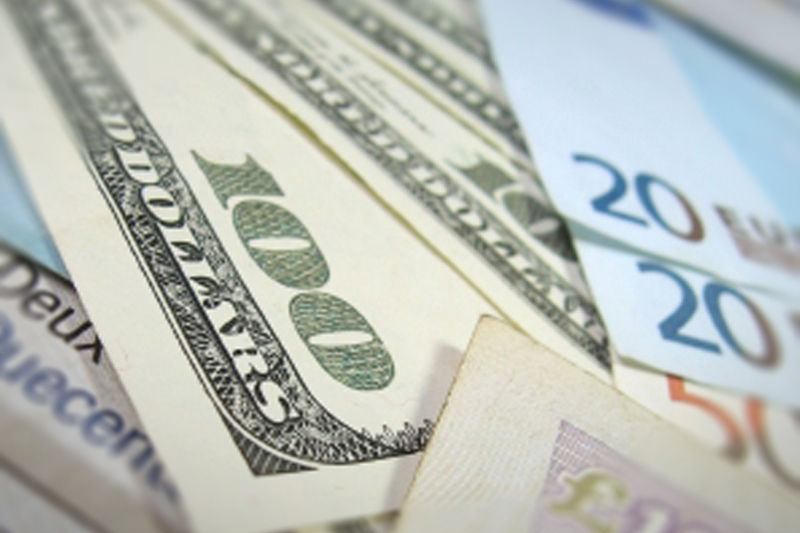Investing.com -- EUR/USD fell sharply on Friday sliding to its lowest level in three weeks, as core inflation in the U.S. rose by its highest annual percentage in more than three years, bolstering hawkish arguments for further interest rate hikes by the Federal Reserve.
The currency pair traded between 1.0912 and 1.1069, before settling at 1.0932, down 0.0086 or 0.78% on the session. The euro has closed lower against the dollar in four of the last five and eight of the last 10 sessions. Since surging to three-month highs earlier this month, the euro has plunged more than 3.2% against its American counterpart.
EUR/USD likely gained support at 1.0538, the low from December 3 and was met with resistance at 1.1496, the high from Oct. 15.
On Friday morning, the U.S. Department of Commerce in a monthly report said that personal income and consumer spending surged by 0.5% in January, both eclipsing consensus' estimates. Driven by sizeable increases in wages and salaries, personal income rose for the third time in four months, building on strong gains from December. Consumer spending, meanwhile, moved steadily higher paced by a 1.2% spike in durable goods purchases.
More tellingly, the Personal Consumption Expenditure (PCE) Index jumped by 1.3% in January from its level 12 month earlier, an improvement of 0.7 from December's level. The Core PCE Index, which strips out volatile food and energy prices, rose by 0.3% from the previous month, extending monthly gains from December. On a yearly basis, Core PCE surged by 1.7% from its level in January, 2015, also 0.3% higher from December's reading.
While Core PCE inflation has remained under the Fed's targeted objective for every month over the last three years, January's reading hit the high end of the central bank's central tendency estimate for 2016. Fed chair Janet Yellen has continually reiterated that long-term inflation will continue to move toward the Fed's targeted goal of 2%, as temporary factors from a stronger dollar and record-low energy prices recede. At the Federal Open Market Committee's (FOMC) December meeting, the committee projected in its median forecasts that inflation will not reach 2% until 2018.
When the FOMC meets again next month, the committee will release its quarterly long-term economic projections, also known as its "dot-plot." The assessment includes long range projections for changes in Real GDP, unemployment, inflation and the Fed's benchmark interest rate. Since the FOMC ended a seven-year zero interest rate policy in December, threats of a global economic slowdown and extreme volatility in financial markets worldwide have prompted the U.S. central bank to reconsider its pace of tightening. The FOMC followed by holding the target range of the Federal Funds Rate at a level between 0.25% and 0.50% at a subsequent meeting in late-January.
But with the labor market nearing full employment, the strong inflation data could compel the Fed to reconsider the timing of its next interest rate hike. In its January statement, the FOMC emphasized that it will continue to employ a data-driven approach when deciding whether it is appropriate to lift interest rates.
"A data-driven Committee, making decisions meeting by meeting, is likely to surprise markets from time to time," Fed governor Jerome Powell said at a speech before the U.S. Monetary Policy Forum on Friday morning. Hours later, Lael Brainard, Powell's colleague on the FOMC, remarked that tightening financial conditions are the equivalent "of three rate hikes."
Any rate hikes by the Fed this year are viewed as bullish for the dollar, as foreign investors pile into the greenback in order to capitalize on higher yields.
Separately, the Commerce Department upwardly revised Real GDP growth in the fourth quarter to 1.0%, up from initial estimates of 0.7%. In Spain and France, February inflation data both came in slightly under consensus estimates.
Elsewhere, GBP/USD plunged 0.61% to 1.3870 after falling to fresh seven-year lows earlier in the session. Since the UK received special status in the EU late last week, the pound has crashed more than 3.2%.
The U.S. Dollar Index, which measures the strength of the greenback versus a basket of six other major currencies, surged more than 0.80% to an intraday high of 98.29, before closing at 98.13. At session highs, the index reached its highest level in nearly three weeks.
